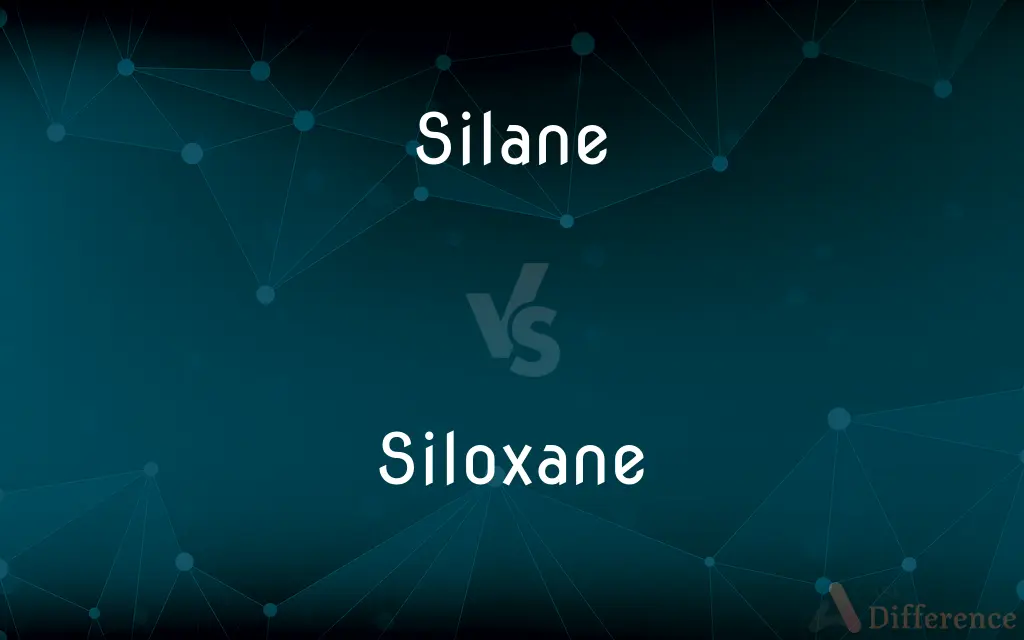Silane vs. Siloxane — What's the Difference?
By Tayyaba Rehman & Maham Liaqat — Updated on March 20, 2024
Silane is a simple silicon-hydrogen compound, while siloxane is a chain of alternating silicon and oxygen atoms.

Difference Between Silane and Siloxane
Table of Contents
ADVERTISEMENT
Key Differences
Silanes are chemical compounds consisting of silicon bonded to hydrogen atoms, with the general formula SiH₄ for the simplest silane. They serve as the building blocks for many silicone-based materials and are used in a variety of industrial applications, such as sealants, adhesives, and coatings. Siloxanes, on the other hand, are larger molecules made up of repeating units of silicon and oxygen atoms, often with organic side groups attached to the silicon. This structure forms the backbone of silicones, providing them with their unique properties, such as flexibility, water resistance, and thermal stability.
The primary difference between silane and siloxane lies in their structure and size. Silanes are smaller and simpler, typically used as precursors or monomers in the production of more complex silicon-based materials, including siloxanes. Siloxanes, with their larger and more complex structure, make up the polymers known as silicones, which are widely used in products ranging from household items to medical devices due to their versatility and durability.
In terms of applications, silanes are often used in surface treatments and as coupling agents to improve the adhesion between organic and inorganic materials. This makes them valuable in industries like construction and electronics. Siloxanes, due to their polymer nature, are used in a broader range of applications, including lubricants, sealants, and medical implants, capitalizing on their stability and resistance to environmental factors.
The chemical properties of silanes and siloxanes also differ. Silanes are generally more reactive, particularly with water, which can lead to the formation of silicon dioxide and hydrogen gas. This reactivity is harnessed in chemical synthesis and in creating protective coatings. Siloxanes, being larger and more stable molecules, are less reactive and more resistant to environmental degradation, making them suitable for long-lasting applications.
Environmental and safety considerations also differ between the two. Silanes can be hazardous due to their flammability and potential for hydrolysis, requiring careful handling and storage. Siloxanes, while generally considered safe, have raised environmental concerns, particularly in the case of certain cyclic siloxanes, which are persistent in the environment and may have ecological impacts.
ADVERTISEMENT
Comparison Chart
Structure
Silicon-hydrogen compound
Silicon-oxygen chain with organic side groups
Applications
Precursors, surface treatments, coupling agents
Silicones, lubricants, sealants, medical applications
Size & Complexity
Smaller, simpler molecules
Larger, more complex polymers
Reactivity
Higher, especially with water
Lower, more stable
Environmental & Safety
Flammable, hydrolysis risk
Concerns with persistence and ecological impact
Compare with Definitions
Silane
Reacts vigorously with water, forming silicon dioxide.
The hydrolysis of silane is an important reaction in producing pure silicon.
Siloxane
A chain of alternating silicon and oxygen atoms, forming the backbone of silicones.
Polydimethylsiloxane is a common siloxane used in silicone lubricants and medical devices.
Silane
A simple silicon compound with hydrogen atoms.
Silane gas is used in the deposition of thin films of silicon in the semiconductor industry.
Siloxane
Concerns with certain cyclic siloxanes due to persistence.
D4 and D5 siloxanes are monitored for their potential ecological effects.
Silane
Enhances bonding between dissimilar materials.
Silane coupling agents are used to improve the adhesion of glass fibers to polymer matrices.
Siloxane
Known for resistance to heat, cold, and water.
Siloxane-based sealants are used in construction for their long-lasting protective qualities.
Silane
Serves as building blocks for producing siloxanes and silicones.
Silanes are employed to modify surface properties before applying silicon-based coatings.
Siloxane
Widely used in medical implants and devices due to inertness.
Siloxane-based hydrogels are utilized in contact lenses and wound dressings.
Silane
Requires careful handling due to flammability and reactivity.
Special precautions are necessary when storing and handling silane gas.
Siloxane
Provides elasticity and flexibility to silicone materials.
Silicone rubber, made from siloxane polymers, is used in a wide range of flexible and durable products.
Silane
Silane is an inorganic compound with chemical formula, SiH4, making it a group 14 hydride. It is a colourless, pyrophoric, toxic gas with a sharp, repulsive smell, somewhat similar to that of acetic acid.
Siloxane
A siloxane is a functional group in organosilicon chemistry with the Si−O−Si linkage. The parent siloxanes include the oligomeric and polymeric hydrides with the formulae H(OSiH2)nOH and (OSiH2)n.
Silane
A pungent flammable gas, SiH4, that is toxic and irritating, used in the manufacture of semiconductors.
Siloxane
Any of a class of chemical compounds of silicon, oxygen, and hydrogen, based on the repeating structural unit H2SiO.
Silane
Any of a group of silicon hydrides having the general formula SinH2n+2 that are analogous to the alkanes.
Siloxane
(chemistry) Any of a class of compound having a short repeating unit of silicon and oxygen atoms (either in a chain or a ring), typically with organic side chains
Silane
(chemistry) Any of a group of silicon hydrides that are analogous to alkanes (the paraffin hydrocarbons); especially the parent compound SiH4
Siloxane
Any of a large class of compounds that have alternate silicon and oxygen atoms
Silane
(inorganic chemistry) monosilane (SiH₄)
Silane
(organic compound) Any organic derivative of monosilane
Common Curiosities
Are siloxane-based products safe for medical use?
Yes, certain siloxane-based products, like medical-grade silicones, are specifically designed for biocompatibility and are widely used in medical applications.
How are silanes and siloxanes similar?
Both are silicon-based chemicals used in the creation and modification of materials, leveraging the unique properties of silicon.
Can silane treatments improve the durability of materials?
Yes, silane treatments can significantly enhance the durability and lifespan of materials by improving their resistance to moisture, corrosion, and environmental degradation.
What is the primary use of silanes in industry?
Silanes are primarily used as precursors to silicones, surface treatment agents, and coupling agents to improve material adhesion.
Why are siloxanes important in the production of silicone products?
Siloxanes form the backbone of silicone polymers, providing the key properties of flexibility, durability, and resistance to environmental factors.
How do environmental concerns differ between silanes and siloxanes?
Silanes raise concerns due to their flammability and potential for hazardous reactions, while certain siloxanes are scrutinized for their environmental persistence and potential ecological impacts.
What role do siloxanes play in personal care products?
Siloxanes are used in personal care products like cosmetics and hair care products for their smoothing, softening, and moisture-resistant properties.
What makes siloxanes preferable for long-term applications?
Their chemical stability, resistance to environmental factors, and versatility make siloxanes ideal for long-term applications in various industries.
Is there any ongoing research to mitigate the environmental impact of siloxanes?
Yes, research is ongoing to develop more environmentally friendly siloxane compounds and to better understand and mitigate the impacts of existing compounds.
Can silanes be found in consumer products?
While silanes themselves are not typically found in consumer products, they are used in the manufacture and treatment of materials that go into consumer goods.
Share Your Discovery

Previous Comparison
Acculturation vs. Assimilation
Next Comparison
End vs. TerminationAuthor Spotlight
Written by
Tayyaba RehmanTayyaba Rehman is a distinguished writer, currently serving as a primary contributor to askdifference.com. As a researcher in semantics and etymology, Tayyaba's passion for the complexity of languages and their distinctions has found a perfect home on the platform. Tayyaba delves into the intricacies of language, distinguishing between commonly confused words and phrases, thereby providing clarity for readers worldwide.
Co-written by
Maham Liaqat














































